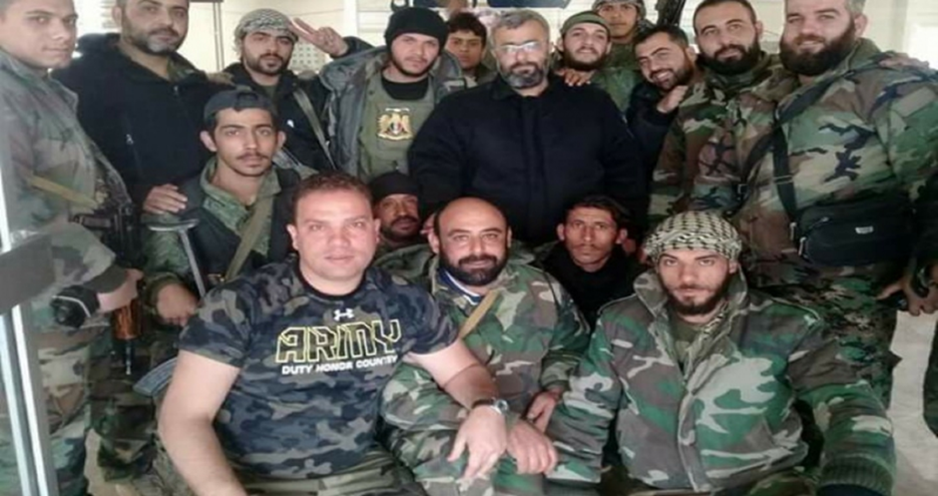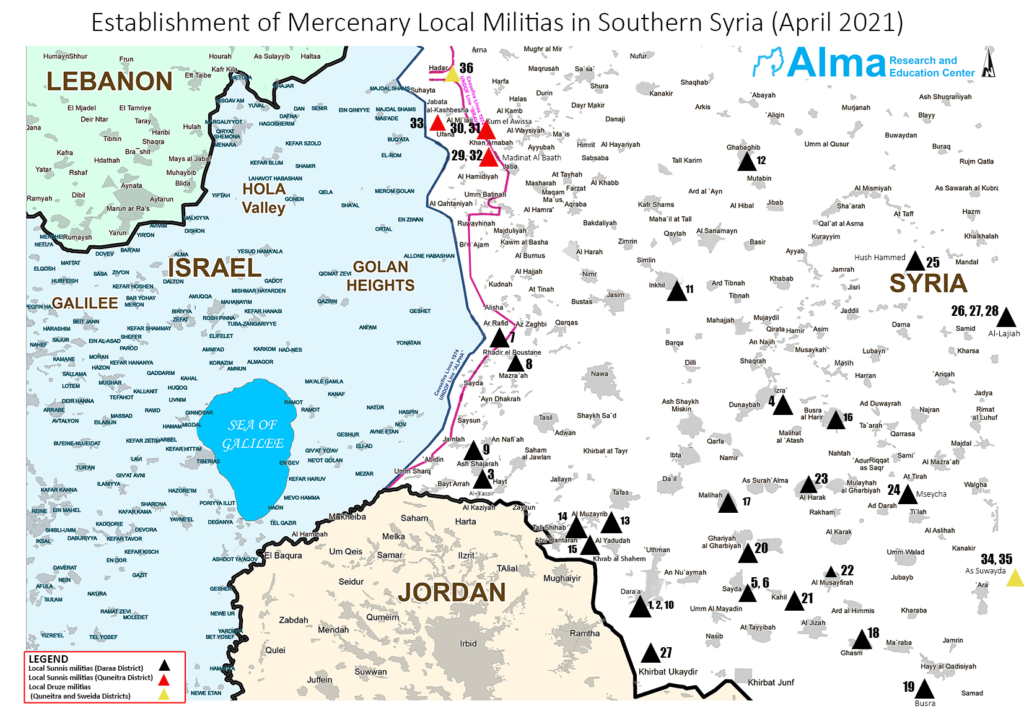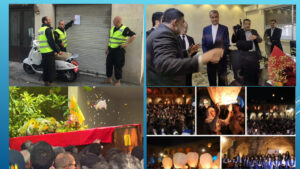The report is based on updated information from the years 2019 – 2020, detailing 36 local militias in southern Syria consisting of locals, Sunnis (Appendices A+B), and Druze (Appendix C). The militiamen serve as mercenaries for the radical Shiite axis led by Iran. The report details these militias according to location, the number of activists, the identity of the commander, and additional information.
These militias are deployed throughout southern Syria and operate in all three southern provinces: Quneitra (6 militias), Daraa (28 militias), and Sweida (2 militias). The loyalty of most of these militias is bought with money, like mercenaries, and not acquired on the basis of an ideological common denominator.
The data collected indicates that the local militias in southern Syria are engaged in a variety of missions on behalf of the radical Shi’ite axis headed by Iran, such as: establishing presence and deterrence (Deterrence towards the local population), conducting activity against those who interfere with the radical Shi’ite axis entrenchment in the region, assistance in the establishment of civic infrastructures, assistance in recruiting new activists, securing the movement of senior axis officials during their exposed and secret visits to the area, weapons, and drug smuggling, as part of the major narcotics trafficking operation run by Hezbollah from Lebanon.

Based on cross-referencing information we have, we estimate with high probability that the militiamen, sometimes perform additional tasks under a different command structure, despite their original militia affiliation. For example, An operative in the local militias listed in this report may be called on to carry out a task for the Hezbollah Golan unit or for one of the special units of the Iranian Quds Force operating in the area like unit 840. These tasks are fundamentally different from the routine tasks of those militias, i.e., the militia operative may also be involved in intelligence gathering and terrorist activities against Israel.
Sometimes the militias also act to assist the activities of Syrian regime forces affiliated and closely cooperating with the radical Shi’ite axis. This mainly refers to the 4th Armored Division, commanded by Maher Al-Assad (the president’s brother) and one of the Syrian intelligence apparatuses known as the “Air Force Security”. They also cooperate with the forces of the 1st. Corps, which are permanently stationed in the southern Syrian sector.
Some of these militiamen previously served in the Syrian army or one of the Syrian security services. Many of them belong to the “people of the reconciliation“, locals who were mostly former opposition figures and even fought as part of the Free Syrian Army and the Jaysh Khalid Ibn Al-Wallid forces (ISIS in southern Syria), against the Syrian regime and against the forces of the radical Shi’ite Axis itself. After the regime reconquered southern Syria in July 2018, they reached an understanding and agreement with the Syrian regime on a mutual reconciliation, i.e., the dismantling of the combat forces established as part of the opposition, handing over some of their weapons (with an emphasis on heavy-duty weapons) and the signing of a “non-aggression” document against the Syrian regime. In return, the regime’s military forces did not enter their communities and did not carry out arrests among them.

Many of the “people of the reconciliation” themselves and their families were medically treated by Israel as part of a “good neighborhood” project. It is not at all certain that they will remember this good for Israel. in all probability if they demand action against Israel they will do so. They will do so because they depend on the money paid to them by the radical Shiite axis led by Iran.
The radical Shiite axis headed by Iran is driven by the power of ideology. On the other hand, most of the local militiamen in southern Syria are in need of money in order to survive and sustain their families. Their ideology is of low priority, if at all. The Shi’ite axis takes advantage of this and this is where the interests of both sides meet: in the not-too-distant past, they were willing to fight against the Iranian involvement, in the present, they are willing to fight on behalf of the radical Shi’ite axis and serve it for an average monthly salary of $50 to $100. In fact, these are mercenaries. A good example demonstrating this is the fact that quite a few expatriates from Jaysh Khalid Ibn Al-Walid Army, former ISIS members living in the Yarmouk Basin, have joined these militias.
Some of the local militias operate under the “Syrian Hezbollah”, an umbrella organization established by the radical Shi’ite axis headed by Iran and supported militarily by Hezbollah Lebanon. Another part of the local militias operates under the civilian veil of civic associations. These associations operate in southern Syria under the auspices of the radical Shi’ite axis. The militias mentioned in this report are actually the military wings of those associations. The most prominent of these associations are “Jamaia Al-Zahara” and “Jamaia Al-Bostan” or in its new name “Al-Arin”, under which the militias “Al-Arin”, “Dir Al-Watan” and “Majmuat Kamil Nasr and Anwar Al-Karydi” operate.
This is a good example presenting the integration of the civilian and military establishment of the radical Shi’ite alliance headed by Iran in Southern Syria, similar to the Hezbollah model in Lebanon where the military and civilian branches are indistinguishable.
Over the past year, the Alma Center has intensely explored the fusion of military and civilian establishment of the radical Shi’ite axis headed by Iran in southern Syria.
Throughout 2020, we published a number of research reports regarding the deployment of Shiite militias and Hezbollah (the Southern Headquarters and the Golan Heights File units) and the civic establishment process in southern Syria.
The reports presented all aspects of the establishment of the radical Shi’ite axis led by Iran in southern Syria. The reports revealed the fact that there are already dozens of sites where Shi’ite axis proxies are deployed: Shi’ite militias, Hezbollah, and its units and local militias. This deployment exists both inside Syrian military sites and more importantly within many Communities in Sunni areas (see Alma Center’s reports).
We now see the outcome of the extensive establishment strategy, accomplished by the radical Shi’ite alliance, enabling the widespread use of the human shield tactic. Many civilian buildings and houses are used and will be used as weapons depots, missile launch sites, and observation posts. We estimate that in the not-too-distant future UNDOF’s movements and activities will be restricted and they too will be prevented from entering villages and moving on certain roads similar to Hezbollah’s restrictions on UNIFIL in southern Lebanon. In our assessment, the proxy forces, led by the local militias, will increase their activities against those who oppose the radical Shi’ite axis establishment.






